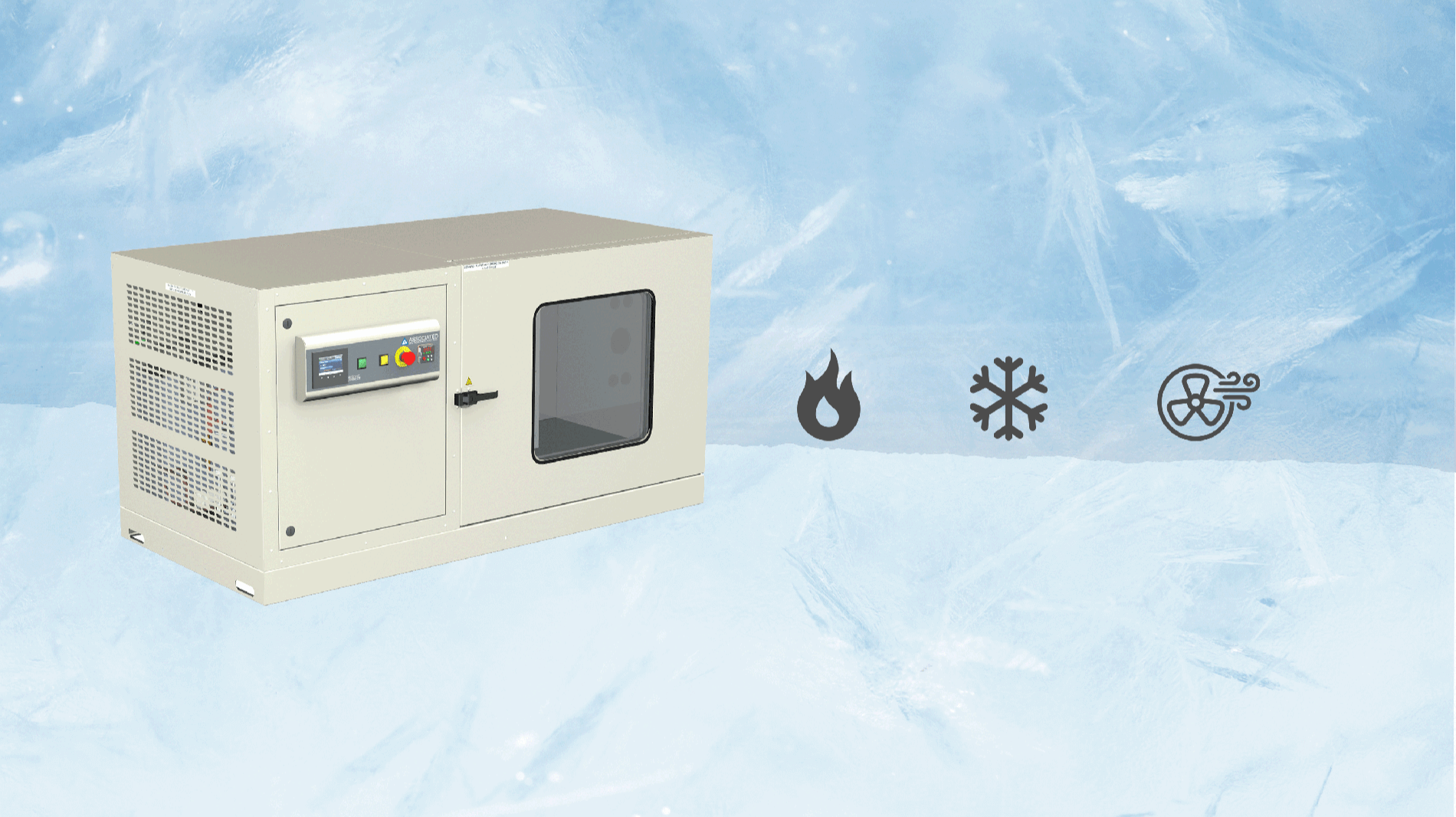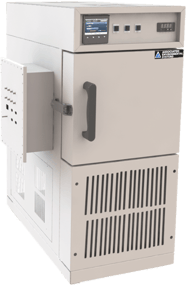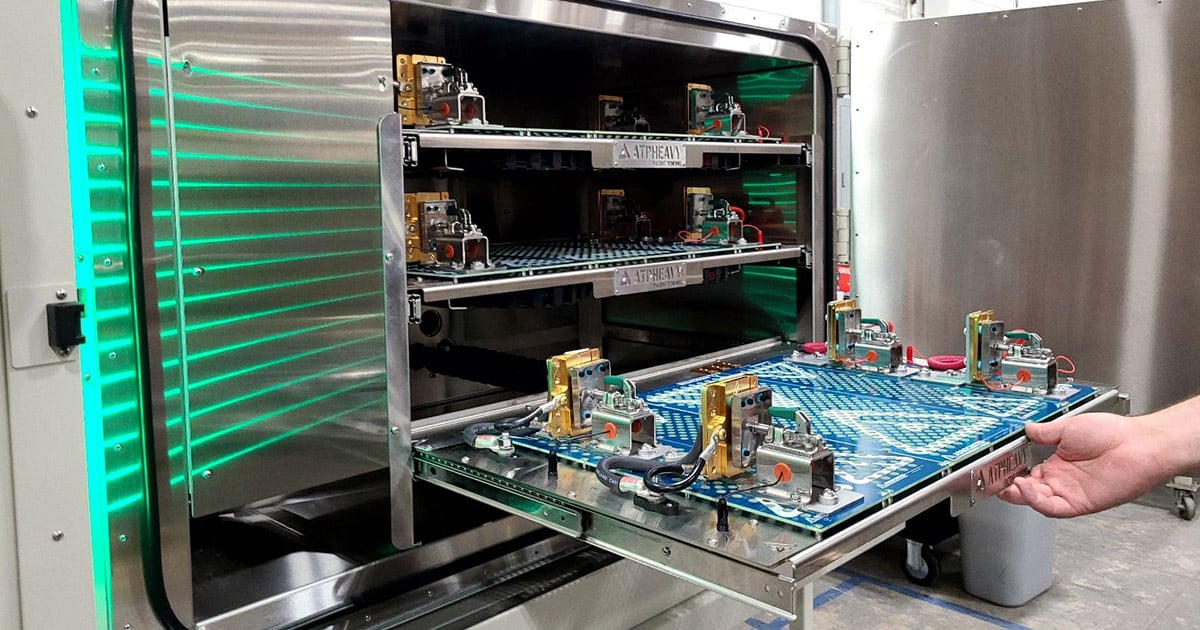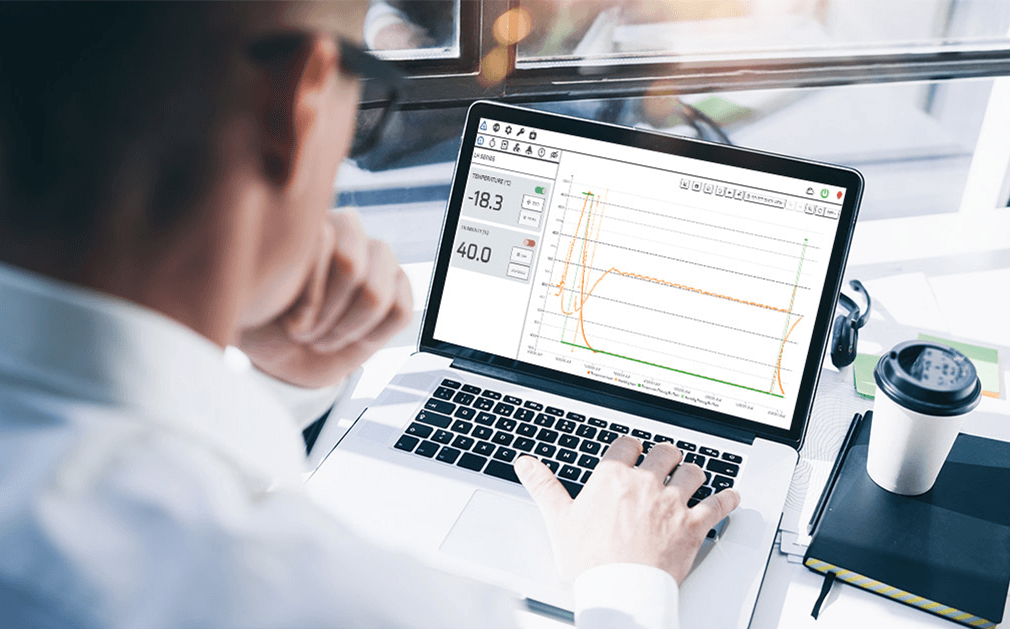Jump to:
- What Is the Price of a Temperature Chamber?
- Industries that Rely on Temperature Chambers
- AES Temperature Chambers
- Temperature Chamber Systems
- Temperature Cycling Vs. Steady-State Testing
- Battery Testing in Temperature Chambers
- Remote Monitoring With AESONE CONNECT
- Temperature Chamber Resources & FAQs
- Request More Info
Environmental Test Chambers for Temperature Testing
Nearly every industry benefits from—if not requires—some form of environmental testing. Be it transportation, electronics, medical devices, packaging, batteries, or military and defense, temperature chambers play a central role in product success, research and development, and safety. A temperature-only test chamber, also known as a thermal chamber, enables controlled test runs by manipulating the temperature conditions of an enclosed space. They vary in size and performance from small test chambers to large walk-in or drive-in rooms.
As an industry leader, Associated Environmental Systems (AES) designs and builds various types of environmental test chambers, standard and custom, to meet your goals. Whether you need a sophisticated chamber for temperature cycling, steady-state testing, or battery testing, AES has a chamber for you. From initial planning to ongoing environmental test chamber maintenance, we’re here for you.
Learn more about our range of environmental test chambers for temperature testing and how we can help move you forward.
What Is the Price of a Temperature Chamber?

The price of a temperature chamber varies tremendously depending on several factors, including size and performance. A small temperature-controlled chamber is less expensive than a larger one.
The more you need from your chamber regarding workspace volume, condition extremes, and change rates, the more you can expect to pay.
Standard temperature chambers typically start at between $15,000 and $20,000. This base temperature chamber price often increases with customizations and optional features (such as boost cooling or battery testing fixtures). Be sure to work with a manufacturer that understands the difference between walk-in and benchtop temperature chamber pricing, depending on your needs.
Industries That Rely on Temperature Chambers
Temperature chambers are critical to product development and validation across a wide range of industries. These chambers help engineers and researchers simulate real-world thermal conditions to ensure performance, safety, and reliability. Whether you’re testing cutting-edge battery technology or ensuring pharmaceutical stability, our chambers are built to meet your unique requirements.
Explore how temperature testing plays a role in each industry:
-
Electric Vehicles (EVs): Validate battery safety and performance under thermal stress.
-
Pharmaceuticals Ensure product integrity and shelf-life through stability testing.
- Medical Devices: Verify performance and reliability of life saving medical devices.
-
Energy Storage: Evaluate cell and pack performance under varying environmental conditions.
-
Aerospace: Simulate extreme environments to verify components for in air travel.
-
Military & Defense: Meet strict military standards (MIL-STDs) with thermal testing.
Want to learn more about how we support each industry? Explore the industries we serve to see how our solutions align with your specific needs.
AES Types of Temperature Chambers
AES offers the following series of temperature-only test chambers:
SD Series
The SD series benchtop temperature chamber is stackable, enabling you to optimize lab space and test more efficiently, including battery testing with an ATP fixture.
Temperature Range: -70°C to +180°C (-94°F to +356°F).
Available Volumes: 2 and 8 cu ft.
SC Series
The SCH Series features the most powerful benchtop chambers in the world. These stackable temperature chambers enable you to optimize lab space and test more efficiently.
Temperature Range: -37°C to +180°C (-34.6°F to +356°F).
Available Volumes: 8 and 12 cu ft.
FD floor models feature fast change rates to conduct high-performance testing and cycling.
Temperature Range: -70°C to +180°C (-94°F to +356°F).
Available Volumes: 1, 2, 8, 10, 13, 18, 27, 36, 48, 64, 80, 96 cu ft.
FDR Series
The FDR Series allows you to test frequency-generating devices within a shielded environment, effectively shielding frequencies from entering and escaping the test chamber workspace.
Temperature Range: -70°C to +180°C (-94°F to +356°F).
Available Volumes: 1, 2, 8, 10, 13, 18, 27, 36, 48, 64, 80, 96 cu ft.
Temperature Chamber Systems
AES carries a wide variety of top-of-the-line temperature chambers from benchtops to walk-ins. You can also purchase rack-and-stack test chambers to maximize your lab space and optimize efficiency. Consider a chamber equipped with ATPPRIME or ATPHEAVY for the safest, most effective battery testing in the industry, or ATPFLEX, a battery testing fixture that can be installed into nearly any chamber.
Standard temperature ranges: -37°C to +180°C (-36.46°F to 356°F) | -70°C to +180°C (-94°F to 356°F)
Precision: ±0.5°C
Ramp Rates: 3.9°C/minute to 9°C/minute and faster
Heating System
The heating systems in AES chambers are all-electric and pass air over fast-response, low-watt-density resistance heaters with a ceramic core, ensuring a long, reliable life with no downtime. The combination of airflow, instrument response, and these fast-reacting heaters gives highly accurate and straight-line temperature control. These heating systems support temperatures upwards of 180°C (356°F), and heaters may be controlled independently or in unison. Heating systems are located in a plenum so that test items are not subject to direct radiation.
Cooling System
The cooling system in AES chambers consists of a self-contained mechanical refrigeration system with a cascade configuration. You’ll have the option of air-cooling or water-cooling. Air-cooling comes with easier installation and is less expensive than water-cooling. However, it produces slower pulldown rates.
Water-cooling systems result in faster pulldown rates and are more energy efficient, but they require a dedicated, conditioned water supply and are more complicated to install.
You can supplement your system with boost cooling employing liquid nitrogen (N2) or carbon dioxide (CO2) for even faster pull-down rates. It's a great option for stress tests that require rapid cooling. Even without boost cooling, AES standard cascade refrigeration systems have the fastest standard change rates of any environmental test chamber manufacturer.
Air Circulation
Air circulation is crucial for environmental testing. AES’s chambers have proprietary baffle and fan design combinations, which optimize temperature conditions within the workspace.
Safety Features
Temperature chambers come standard with a few key safety features. A high/low temperature control function enables you to adjust testing conditions so they do not exceed a certain temperature limit above or below what is set for the device under testing (DUT). This includes an internal high-temperature safety component and refrigeration system over-pressure safety circuit. These elements combine to help protect your product throughout the testing process.
Additionally, temperature chambers designed for battery testing come equipped with standard and additional safety features that are key in preventing thermal runaways. AES SAFE chambers have safety features rated up to EUCAR level 7. They protect products and labs and keep user safety in mind so you can innovate with confidence.
Radio Frequency Shielding
Some companies need to block radio frequencies during their testing because they can affect the performance and functionality of DUTs. This is also important for compliance. In the form of the Federal Communications Commission (FCC), the United States government strictly enforces safety restrictions on radio frequencies. The regulations cover everything from broadcast television and radio to satellite communications and aeronautical navigation.
AES builds some temperature chambers with RF shielding that features the following:
- Cellular, metallic, chromatic gaskets and conductive adhesives that seal the workspace
- A honeycombed RF-shielded grill that keeps the circulation motor cool
- Electrical wiring fed through special RF filters
- Standard and customer-requested RF-rated connectors, installed on a side-mounted interface plate to provide a shielded pass-through grid so you can communicate with the DUT
The level of attenuation (the strength of the signal the test chamber blocks and, by extension, isolates) varies as well. Each test chamber is certified by an independent facility prior to being shipped.
Temperature Cycling Vs. Steady-State Testing
While heating and cooling are also utilized in other types of test chambers, such as salt spray and humidity chambers, temperature-only test chambers are primarily used for temperature cycling or steady-state testing.
Sometimes referred to as thermocycling, temperature cycling focuses on exposing DUTs to alternating low and high temperatures to identify breaking points and durability. Repeating these temperature changes enables engineers to analyze how well DUTs are likely to perform under real-life conditions.
Temperature cycling reveals early-term defects including short-circuiting, cracking, breaking, warpage, debonding, and seal failure. This is done by saturating DUTs in cycling temperatures over several hours.
Temperature cycling is similar to thermal shock testing. The primary difference between the two is found in how rapid those temperature changes happen. Shock testing exposes devices to opposite, extreme temperatures immediately while temperature cycling is more gradual.
Cycling requires fast change rates from higher-performance chambers. AES accommodates users by providing four standard performance levels in the FD Series for chambers 18 cubic feet to 96 cubic feet in volume.
The change rates may vary by chamber size, DUTs, and the ambient conditions of your lab.
Towards the other end of the performance spectrum, steady-state or stability testing exposes DUTs to a constant temperature over an extended period. Be it textiles, pharmaceuticals, electronics, or cosmetics, steady-state testing is another means of assessing a product’s durability and how it will perform in a real-world environment.
Although it’s focused on testing product sturdiness, stability testing is frequently employed to evaluate packaging stamina, as well.
Battery Testing in Temperature Chambers

Advancements in battery technology—how they’re made, shaped, and used—require rigorous testing for safety, performance, and reliability. Companies utilize temperature chambers, and sometimes humidity chambers, for this purpose.
The results are often world-changing. Rechargeable batteries power not just our cell phones, tablets, and laptops but also medical devices, drones, and more. Increasingly, companies are investing significant time and resources into developing longer-lasting, faster-charging batteries for electric vehicles to help manufacturers meet consumer demands and achieve their carbon emission goals.
All of these batteries must be evaluated before being packaged or included in a device shipped to market.
AES has designed battery test chambers (with extensive safety features) to expand a company’s ability to conduct battery research and development in controlled conditions, enabling them to innovate toward a brighter future.
Patented ATPPRIME
The patented ATPPRIME, available in several AES temperature chambers, enables testing of almost any battery format, including coin, cylindrical, pouch, prismatic, and pack cells. The fixture can seamlessly rotate between battery types using universal Kelvin connectors. Each connector is safely accessed by sliding shelves capable of accommodating loads holding up to 48 cells across four levels.
Patent-Pending ATPHEAVY
ATPHEAVY enables testing of up to 1000 amps per channel. It is designed specifically to accommodate large prismatic and pouch cells that power electric vehicles. In addition, ATPHEAVY ADAPTABLE is a first-of-its-kind solution. The modular board allows your custom-tailed future to support different amperage, cell sizes, and formats. With one adjustable fixture, you can conduct all your high-amperage testing needs in a single chamber.
Both the SC-512-4-SAFE and SC-508-SAFE, two of the most powerful benchtop temperature chambers in the world, can be equipped with ATPHEAVY or ATPHEAVY ADAPTABLE. You can also stack multiple chambers to maximize testing efficiency.
Watch AES ADVANTAGE featuring ATPHEAVY ADAPTABLE
Do you already have an environmental chamber and want to test batteries? Explore ATPFLEX, a fixture that can be integrated into your chamber and capable of testing coin, cylindrical, pouch, prismatic, and pack cells.
Remote Monitoring With AESONE CONNECT®

The days of standing next to your chambers to observe ongoing tests are over. AES temperature chambers come standard with AESONE CONNECT®, a combination of hardware and software solution that enables you to monitor tests remotely. You can view real-time and historical data, create, edit, save, and move between test profiles from anywhere you can access a web browser.
Watching from a full-screen monitor, AESONE CONNECT® empowers you to design and rearrange tests with visually intuitive plot lines, clear data intervals, and colorful graphs. Furthermore, sharing a chamber is not a security problem. The administrator controls multiple login authentication methods and user-access permission levels and can establish expiration dates for each user.
If your budget can’t afford to purchase a new temperature and humidity chamber, AESONE technology can also be retrofitted to nearly any chamber you own. An AES team member will examine your configuration and retrofit the AESONE XCHANGE hardware to your chamber so you can connect to AESONE CONSOLE software.
If you have 10 or more chambers at one or more locations, AES has a new AESONE solution for management. Contact us today to find out if it’s right for you and to receive a quote.
Temperature Chamber Resources & FAQs
Temperature Chamber Considerations: System Components & Power
Before you purchase a test chamber, it's important to understand the system components and power as they pertain to the devices you plan on testing. Read More
Learn More About AES Benchtop Test Chambers
Temperature chambers can range from small benchtops to large walk-in or drive-in chambers. Read More
The Best Temperature Chambers for Battery Testing
The ideal temperature and humidity battery testing chambers comprise high-performance materials and designs, versatile fixtures, combination hardware and software instrumentation, and more. Read More
The Best Temperature Chambers for Battery Temperature Cycling
Industry-leading temperature chambers for temperature cycling have powerful compressors. They include temperature ranges from -70°C to 180°C, reliable conditioning systems that control temperature within ±0.5°C, various cooling system options, and a remote control to monitor testing from anywhere. Read More About Temperature Cycling.
The Importance of Testing Batteries in High & Low Temperatures
Battery test chambers enable you to rigorously test your batteries in controlled conditions, including high and low temperatures, to ensure they perform as expected.The Importance of Testing Batteries in High Temperatures
Battery test chambers enable you to rigorously test your batteries in controlled conditions, including high temperatures, to ensure they perform as expected. Read More
Troubleshooting: Common Temperature Chamber Questions
- What preventative maintenance should I perform on my chamber’s refrigeration system?
- What preventative maintenance should I perform on my chamber’s electrical system?
- How fast can my chamber ramp up and pull down?
- Why does my chamber not have a temperature pull-up?
- Why does my chamber have a temperature pull-up above the controller setpoint?
- Why is there poor air circulation within my chamber?
Request More Info
Associated Environmental Systems is committed to long-term, responsive relationships with our customers. Looking to purchase a new chamber? Have questions about service, support, or retrofitting an existing chamber?
Don't hesitate to contact us with your questions or challenges.
.png?width=365&height=282&name=SD-508%20(2).png)
